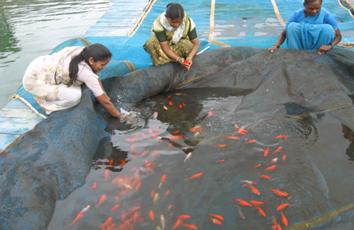Overview
Ornamental fishes are nature's wonderful creation. Ornamental fish keeping is the second most preferred hobby in the world and the number of hobbyists for ornamental fish keeping is rising day by day because it provides a great opportunity for entrepreneurship development and income generation. There are a number of promotional schemes from various government agencies, which would boost up aspiring entrepreneurs. The technology is quite simple and easy to take up and attain success.
Taking advantage out of this, Shashwat started organizing the displaced ethnic communities resettled along the periphery of the Dimbhe reservoir in 2003. People were assisted in securing fishing lease in 2006. Shashwat could mobilise technical assistance of Central Institute of Fisheries Education (CIFE) of the Govt. of India and the State Fisheries/ Tribal Development Departments for supporting in the stocking of reservoir with fish fingerlings, more boats & fishing nets. The tribal have developed technical and managerial skills in reservoir fisheries management, acquired more boats and fishing nets, have been able to stock the reservoir with appropriate size and number of fish seed of desired species and significantly enhanced fish production and profit.
Objectives
To support tribal dam- displaced fisher women to set up a side business for increased economic security.
To support the tribal women to become empowered to stand on their own feet and to stay firm in the ornamental fish market.
Activities
It is planned that 40 tribal women will start the business of rearing ornamental fish. 32 women in all have undergone training in these aspects. However in the first phase 20 selected women will be taking up this work. They have worked for the past 3 years on rearing ornamental – goldfish. They have got the small fish seed from Mumbai and cared for it and fed it and checked and monitored the progress and the growth of the fish as per the directions of the scientists of the Central Institute of Fisheries Education CIFE Mumbai. Due to their diligence the CIFE use 2 of the 16 floating cages work for 2 years and they could get good results out of it. Till now they have taken out 4 crops of goldfish. The goldfish reared in the floating cages of Dimbhe changes its colour in about 3 months due to some special quality of the water, and taken on a red-gold hue which is very attractive. The goldfish reared by these women have been accepted as brooders by the CIFE. They were sold from there by advertisement on the website of CIFE. Subsequently the women were able to convince the Director CIFE to support them by providing some infrastructure. Hence the CIFE applied to the NFDB and a set of 16 cages was approved worth about Rs. 5 lakh, which has very recently been fabricated and floated in the waters of Dimbhe. It is now ready to take fish seed. In the meantime these women have gone to other sources and got further training and have linked up with other women and one group at Lanja in Ratnagiri dist. who are at present doing this business for the past one year. They have recently diversified and experimented with Koi and Angel-fish, which they have successfully been able to rear in the cages and kept in aquarium tanks.
Shashwat have also been able to exhibit samples of goldfish at the Maharashtra State Matsya Mahotsav 2010 held at Mumbai in Dec 2010 for 3 days. A stall was provided by the State Fisheries Dept. to exhibit the work of the tribal fisherfolk of Dimbhe by the Fisheries Co-op. Society and Shashwat. Here exhibited goldfish as well. It is pleasure to inform that the red-gold shiny goldfish were a big crowd-puller and had lots of visitors including women and children. Besides, 18 wholesalers expressed interest in placing orders. The women have utilized these opportunities for the sale of their ornamental fish. Besides this the Taraporewalla Marine fish Research Centre Mumbai have also offered to put these women in touch directly with aquarium owners and wholesalers in Mumbai. Many Govt. officers who have visited also supported to help in marketing aspects.
It is expected that goldfish of size 100 mm could get between 10 to 20 Rs per pair on wholesale and for retail the price could go up to double this. Expenses incurred are estimated as Price of small fish seed include transport is expected to be Rs.3/ to 6/- for 3 different varieties.
Conclusion
It is proposed that these 40 women will start this work with existing 16 cages and continue in additional 16 cages. The actual work involved will be to bring very small fish seed and to rear it to large size. All women will manage the work on the floating cages and of making glass aquariums etc. turn by turn. This includes cleaning the cages, feeding the fish every day, taking the measurements and monitoring the progress periodically etc. It is proposed to take at least 2 crops of ornamental fish in the first year and subsequently this number may be increased up to 3 crops annually and then to try to see if they can take 4 crops out per year. This would lead to enhancement of family income and the women shall be able to utilize their time in a more productive manner. In the cages the women will work in a community manner, whereas in the small pits and fabricated tanks they will rear the ornamental fish individually. So both the types of work shall be carried out.



